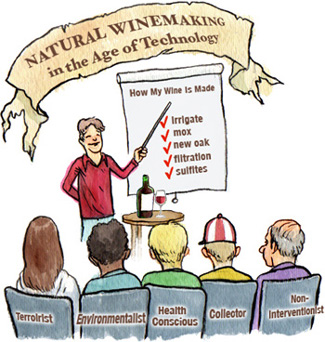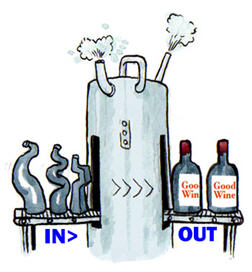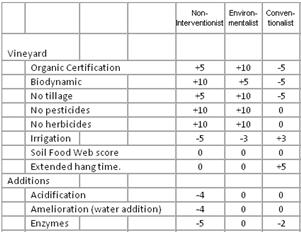

The Natural Wine movement contains several strange bedfellows whose agendas can’t all be satisfied by a single set of winemaking rules.
Natural Wine:
Choosing Your Priorities
by
Clark Smith
April 25, 2008
 any consumers realize that we live in a Golden Age – the consumer has never had it so good. We have twenty times the choices we had two decades ago, and the incidence of poor wines has nearly vanished. If what you are after is drinkable quaff, you will find it more consistently and cheaply than ever before. And the New World has learned how to make Big Wines, just as workaday Hollywood now pumps out Action/Adventure blockbusters with machine-like dependability.
any consumers realize that we live in a Golden Age – the consumer has never had it so good. We have twenty times the choices we had two decades ago, and the incidence of poor wines has nearly vanished. If what you are after is drinkable quaff, you will find it more consistently and cheaply than ever before. And the New World has learned how to make Big Wines, just as workaday Hollywood now pumps out Action/Adventure blockbusters with machine-like dependability.
But the new millennium hosts a growing discontent with impact wines that lack finesse, fruit-forward styles which die young, and global monster wines which are hard to tell apart. The internet now resounds with voices demanding ”somewhere-ness”. Many critics, newly aware of the recent technological revolution in winemaking, have sought to demonize new winemaking techniques as sources of shallowness and sameness.
These arguments haven’t gone smoothly.
Two circumstances lie at the root of the considerable confusion which surrounds this subject. First, the rapidly expanding availability of new tools, coupled with a decreased willingness to share techniques, has led to a substantial information gap between winemakers and their customers, and a sudden sense of betrayal has emerged, leaving wine lovers with a desire to get back to basics.

Spoofulated or Artisanal?
To whit: The Natural Wine movement contains several strange bedfellows whose agendas can’t all be satisfied by a single set of winemaking rules. The more knowledgeable you get, the clearer it becomes that there is, in fact, no consistent stance that satisfies all players.
A simple example is the Federal requirement that all organic wine be sulfite free. This untimely bureaucratic decision has spawned a category crammed with defective and inconsistent products, which is shunned by nearly all producers and most serious buyers. Bingo: a schism between connoisseurs and health activists.
The Eight Constituencies Of The Natural Wine Movement
Below are the eight constituencies of the Natural Wine movement and a few words describing the motivations of each. I recommend to readers to peruse this list and rank them in the order in which you identify personally with each.A. Non-Interventionist. Wine should not be fooled around with. Traditional winemaking is fine, but techniques which cheat or hide flaws are reprehensible. The best wine makes itself.
B. Environmentalist. Winemaking should not damage the environment. Concerns include erosion, petrochemicals, deforestation caused by barrel production, carbon deficit and recycling.
C. Conventionalist. I don't want to drink anything I can't pronounce. Give me standard winemaking without all the weird stuff.
D. Traditionalist. Pre-modernist who prefers time-tested methods; the older the better. I’m suspicious of all recent technological innovations including the use of electricity, chemistry, microbiology, genetic manipulation and petrochemical agriculture.
E. Health-conscious. I want to control my food sources and protect the health of winery personal as well. In addition to restricting the use of chemicals in vineyards and in wine, I prefer moderate alcohol and need full disclosure of potential allergens.
F. Collector. Serious investment in age worthy wine requires dependable microbial stability. My passion is great wine that improves with time. Don't take chances on my nickel. Techniques that haven't stood the test of time make me nervous.
G. Authenticity Enthusiast. Wine should be made from grapes alone, with as little addition and manipulation as possible in order to present a distinctive expression. If Nature gave us a difficult vintage, let's taste it!
H. Terroir Enthusiast. I want to taste the unique flavors of a place. Please don't obscure the wine's distinctive expression with excessive alcohol or wood, or employ practices that make wines all taste the same.
The table below is not data of any sort. I have simply expressed in numbers my own guesses about the way a person in each of the above categories, one sufficiently hip to the ins and outs of that topic, would rate each issue listed. In this scale, +10 is very favorable and -10 is very averse. Ratings are my own estimates of what a well-informed proponent of each position would be expected to conclude. I’m proposing here a temporary working algorithm which we can adjust later in response to reader comments.
Now take your top two categories and scan the table below, looking for disparities in ratings between one of your positions and the other.
Those are the issues for you to study in order to develop a personal position. That’s what my blog is for. To get started in your research, just use the Search function to bring up my blogs on these subjects.
As you can see, despite mutual attraction to the aesthetic trappings of naturalness, there is room for lively debate on its ethics among these groups. I’ll touch on a few more points of difference.
From the conventional perspective, French oak barrels symbolize the epitome of artisanality, separating the diminutive chapels of the boutique elite from the immense tank farms of the typical Central Valley industrial mega-producer. Yet, to the informed environmentalist, they represent the grossest form of wastefulness and affluent display, which today is no longer restricted to small wineries.
The trees from which French oak barrels are made must be 200 years old, and ever since Robert Mondavi chose the device of installing a hundred thousand barrels to distinguish his infant Woodbridge within the Big Valley, Bronco and other competitors have followed with six figure installations of their own. Today, the lion’s share of barrels are housed in vast Valley warehouses, resulting in deforestation on a scale unanticipated by plantings and never before seen.
For each of these venerable trees, 75 percent of the prime wood is discarded because it cannot be fashioned into a piece of fine watertight furniture. These portions can instead be used as sources of oak extractives (chips, staves, nuggets or whatever), and in conjunction with existing neutral











 READER FEEDBACK: To post your comments on this story,
READER FEEDBACK: To post your comments on this story,





